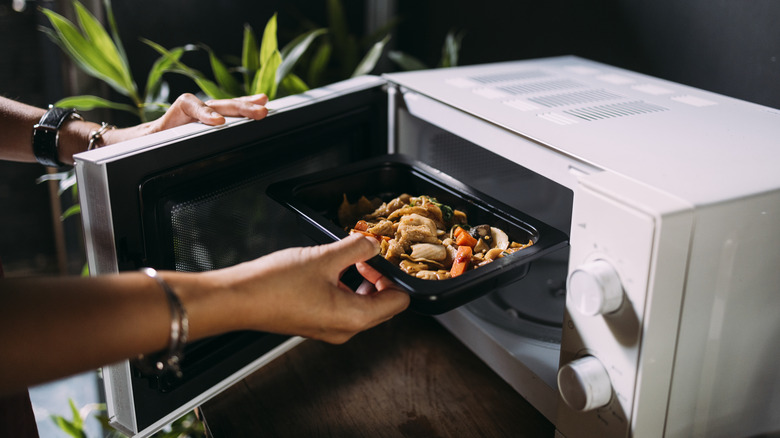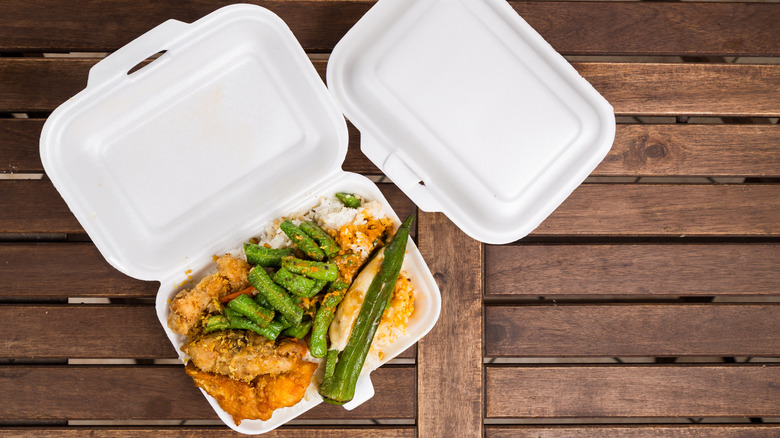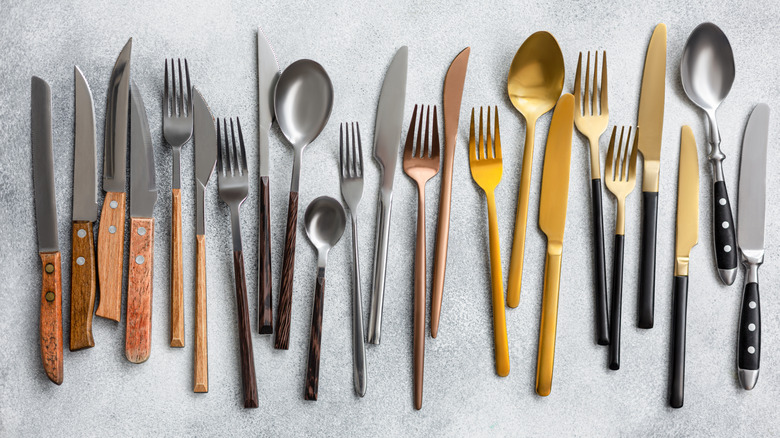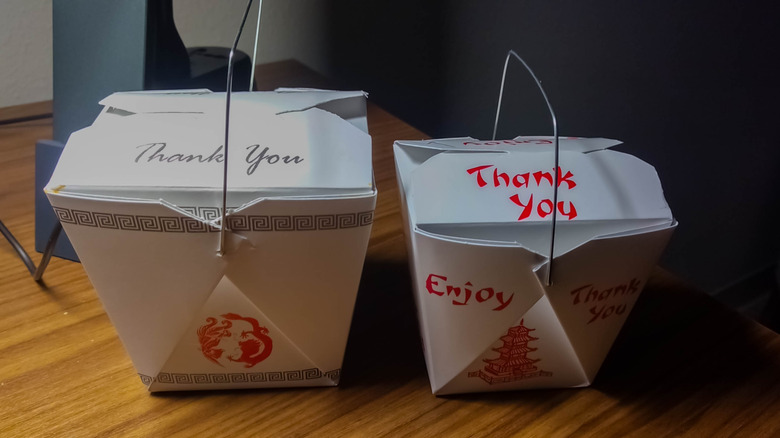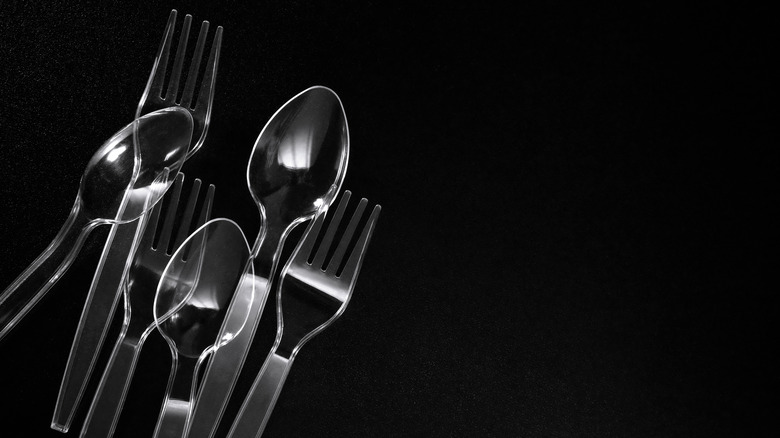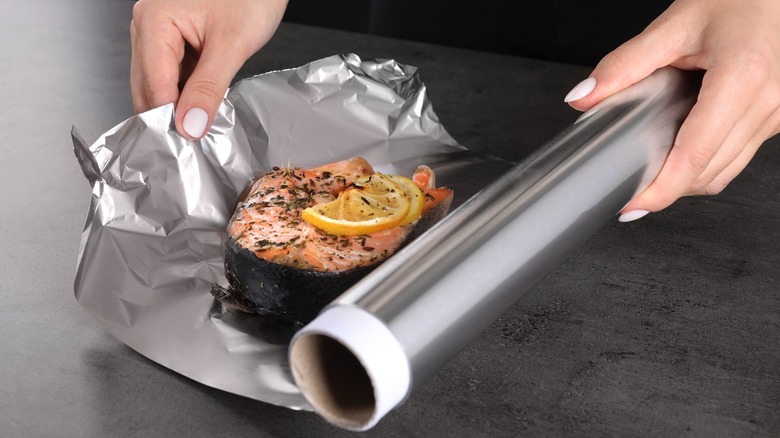Never Put These Everyday Items In The Microwave
The microwave seems like a simple enough appliance. Put your food inside, press a button or two, and not too much time later, you have a hot meal. Turns out, there's a little more going on with that hot box in your kitchen. Plenty of common, everyday kitchen items need to be kept away from your microwave, for fear of destroying either your food or the appliance itself (you decide which is the bigger tragedy). In some cases, there's even the risk of starting a kitchen fire. Between this and avoiding microwave cleaning mistakes, who knew that everyone's favorite midnight snack machine could have so many pitfalls?
Fortunately, the items on this list are at least a little intuitive. You can get around many of these dangers by simply paying attention to labels or using microwave-safe plates and bowls to reheat your grub. Once you're sure about kitchen safety, you can get back to chowing down on some hot and tasty snacks. Don't forget to use the microwave's power level button to maximize the deliciousness. Let's not get ahead of ourselves, though. Safety first! Here are some things that are likely in your kitchen but should never cross paths with the inside of your microwave.
Styrofoam and expanded polystyrene (EPS) foam containers
Unless it is specifically marked as microwave-safe, that plastic container you brought your restaurant leftovers home in should not go in the microwave. The intense heat from the appliance can leach chemicals into your food. Not the fun chemicals, either. And while most of us describe these as Styrofoam containers, most of them are actually made of a different substance called expanded polystyrene (EPS) foam. When heated in the microwave, EPS foam releases the types of chemicals that potentially cause cancer. EPS foam can also melt, which is a pretty horrifying thing to contemplate, given that you're hoping to consume what's inside that takeout container. It's probably unsurprising that a material that never biodegrades would also be dangerous when exposed to the high temperatures and radiation of a microwave, but it's good to know exactly why. Want to reheat your leftovers? Grab a plate or bowl out of the cabinet and toss that EPS foam in the trash when it's empty.
If EPS foam is such a disaster for the microwave, why is it such a widely used material for transporting food? Well, besides being one of the types of containers that don't belong in the microwave, EPS foam does have one or two redeeming qualities. The material is a great insulator, meaning it keeps hot things hot and cold things cold. It's also naturally resistant to moisture, which helps keep food fresh. Setting aside the environmental costs of EPS foam, there's a reason you see so much of the stuff in food service. Just remember that EPS foam doesn't have a role in the reheating process.
Metal utensils and dishes with metallic glazes
Metal in the microwave is going to spark quickly. That's because heat absorbs into metal, and it won't be long before there's a risk of kitchen fire. So don't leave your spoon in your bowl of soup; don't leave a fork on a plate. This is one of those times when forgetfulness around a microwave becomes dangerous. Something else to remember: Cutlery isn't the only thing that can light up. Many travel coffee mugs have metal insulation that can become a problem in the microwave. Make sure to check any travel drinkware before chucking it in your hot box.
Oh, and about those plates? Check to make sure that any dish that you are using is microwave-safe. Make sure it doesn't have a metallic glaze, either. Some plates even have a thin strip of metal along the edges, and that's a sign that the plate is no good for the hot box. Mainly, you just need to remember to check for a microwave-safe label.
Cardboard
This one is largely about Chinese takeout containers with metal handles. Metal and microwaves do not mix. That General Tso's chicken is not equipped for a fiery war between a container and a kitchen appliance. Yes, Chinese takeout boxes can be unfolded into plates, but their extra utility does not extend to the reheating process. Additionally, there are other types of cardboard boxes that should avoid the hot box. Cardboard with ink, cardboard with adhesive, and cardboard with a lining of any kind are not safe for the microwave. Basically, you should always look for a microwave-safe label before chucking any kind of cardboard into the hot box.
Yes, cardboard can have some surprising kitchen applications. Alton Brown makes a smoker out of cardboard, for one. And yes, there are certain types of microwave-safe cardboard. If you buy a pre-prepared meal that tells you to heat the food while it's still in the packaging, that company is not secretly trying to trick you into burning down your house. In general, though? Err on the side of caution. If you don't see a microwave-safe label, don't microwave that cardboard. More than anything, though: Do not reheat Chinese leftovers in their takeout containers.
Zip-top bags
If the zip-top bag you're using is explicitly labeled as microwave safe? Then go for it. Look for markings on the bag or the packaging, usually a square with squiggle lines in the center. Otherwise, absolutely do not put zip-top bags in the microwave. The worst-case scenario is that the bag melts, leaving your microwave a pretty gnarly mess. More likely and less avoidable, though, is that the bag starts leaching chemicals into your food. Chief among these harmful chemicals is phthalates, a chemical that makes plastic softer and has been linked to certain types of cancers. Several types of phthalates are legally allowed in food containers in the United States, even though the European Union has banned the chemicals in packaging. Not just for food either. They are also banned from children's toys and cosmetics.
The temptation to simply reheat the food while keeping it in the same vessel it was stored in is understandable. Maybe you're pulling something out of the freezer, and you just want to thaw it for a few seconds. Unfortunately, there is not really a safe amount of time for a zip-top bag that is not microwave safe to be in the microwave. Find a plate or bowl that can stand up to the heat instead.
Single-use plastic
This warning applies to plastic utensils that might have come with your takeout food. It's surprisingly easy to grab a container of last night's fajitas out of the fridge, stir it up a little with a plastic fork, and then absentmindedly leave the plastic fork in the bowl of meat and veggies while you reheat it in the microwave. Avoid this at all costs! There are enough microplastics everywhere as it is. You should try to prevent them from intentionally entering your food, you know? Even if you are fastidious about plasticware, though, other single-use plastics are probably hanging around your kitchen, too.
Another common kitchen practice that this warning applies to is repurposed butter or yogurt tubs. Reusing the containers of store-bought items, like butter or yogurt, is a great practice. The tub gets reused, which is a positive. You often put leftovers in these tubs, which also cuts down on waste. It's win-win as far as waste reduction goes. Make sure not to put those tubs in the microwave, though. Plastic and microwaves simply do not mix. You're at risk for chemical leaching at best and a melted tub at worst. Either way, you're still hungry.
Aluminum foil
This is perhaps the most well-known cautionary tale on this list. Pages upon pages of YouTube search results are dedicated to people finding out what happens to aluminum foil in a microwave. Don't put aluminum foil in the microwave – that's one of the earliest warnings you get in life. Then again, who hasn't absentmindedly tossed half a leftover Chipotle burrito in a microwave, only to immediately realize that their lunch was now a fireball? Not pretty. Keep aluminum foil out of the hot box.
Thin sheets of metal get hot really quickly and hold a lot of heat. Food products like Hot Pockets or some canned soups take advantage of this fact with small amounts of metal in a food's packaging. That is carefully calibrated, microwave-safe packaging, though. Regular aluminum foil in the microwave simply results in flames and possibly a ruined microwave.
Now, it is true that you can cook with aluminum foil. Who doesn't love an easy wrap-and-cook dinner on a busy weeknight? Just remember that foil-wrapped dinners are for the oven or the grill. Don't try to take shortcuts and use the microwave.
Certain types of takeout containers
It's a reasonable enough calculation. The restaurant already gave you a food container. Why dirty a dish when you want to reheat your grub? Why take the time to get out a plate or a bowl, scrape the food into a new vessel, and then reheat? It'd be so nice to just chuck the takeout container in the hot box and be done with it. The reality is that too many types of takeout containers are not microwave safe. You can't just roll the dice. Sometimes, the manufacturers who made the containers don't even know the exact chemical makeup of the container.
In fairness, many restaurant containers are microwave-friendly, or at least purport to be such. It is best to ask a restaurant employee or look for an explicit marking on the container before microwaving, though. That safety marking is often a square with squiggly lines in the middle — if you squint, it'll look like a microwave. In most cases, microwave-safe containers are made from polypropylene, or PP, and are labeled #5. PP is considered a safe material for microwaves. Can't keep a complicated chemical name in your memory bank? Put your leftovers on a microwave-safe dish before reheating.
Grapes
You might notice that this list has been solely focused on household items that can't go in the microwave. We thought there should be an exception for grapes, though. If you don't know about how grapes will burst into flames in a microwave, we suggest you head over to YouTube. Rather than attempt the experiment yourself, watch what happens when others try microwaving grapes, according to a post from Science Magazine. Within seconds of putting grapes in the hot box, sparks start flying between individual pieces of fruit. Those sparks turn into the grapes melding together, then bursting into flame. Talk about a burning love.
What's happened here is that the energy the microwave emits is being absorbed by the grapes. That's what you want food in a microwave to do, but that tiny space between grapes is where the madness starts. The waves start bouncing back and forth, charging the energy in the space between the grapes to an intense heat. Electrolytes get supercharged, and eventually, a brief explosion of plasma happens. Honestly? That's a pretty cool science experiment. Just don't try it at home, yeah? No one wants to go appliance shopping.
